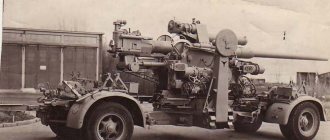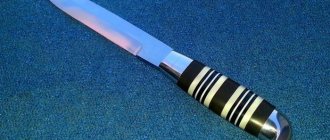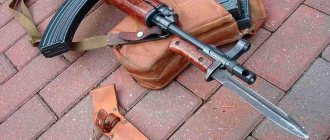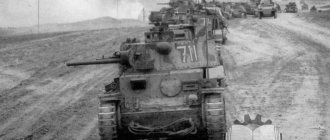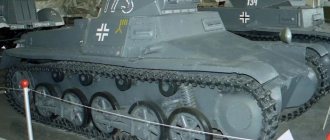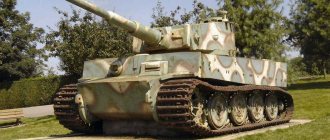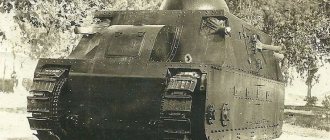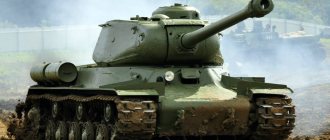The first tanks of the First World War
With the outbreak of the First World War, the need to create fundamentally new means for breaking through enemy fortifications became obvious. The idea of creating such a weapon was first voiced in England in December 1914 by Captain Maurice Hankey, and six months later, Colonel of the Engineering Troops Ernest Sweeton proposed his concept of creating armored machine gun carriers, which was embodied in the Mark I tank.
The British Mark I
Mark I was produced in two versions - “male” and “female”. The difference is in the weapons. The “men” were armed with two 57 mm cannons and 4 machine guns. The “female” version was represented by five machine guns - 1 Hotchkins and 4 Vickers. In all other respects, there are no differences: weight is about 30 tons, dimensions are 8.05 x 4.26 x 2.24 m, average speed is about 6 km/h with a cruising range of no more than 20 km, the crew led by an officer is 8 people.
In response, the Germans are creating a 30-ton A7V based on the Holt tractor. Work on its creation was entrusted to a group of engineers led by Joseph Feuler. The tank's dimensions were not much different from the Mark I (7350 x 3060 x 3300 mm), but it was 2 times faster and could travel 15 km more. The crew of 18 looked impressive. The A7V was armed with a 57 mm cannon and five MG-08 machine guns.
German tank A7V with crew
How British bombing killed "Mouse"
In 1944, after testing prototypes, they planned to launch mass production of these super-heavy tanks - 10 vehicles per month.
In July 1943, the hull of the first Maus was welded at Krupp and work began on hulls for another 6 tanks (sheets were cut and preparations were made for assembly).
British intelligence did not know about the existence of the Mouse project, but British bombers played a significant role in the fate of this super-heavy tank.
German Maus tank during the war years
They dealt severe blows to the Krupp factories, which forced the Germans to push back the release date of the Maus turret by several months. The damage to the enterprises turned out to be so serious that it was necessary to stall this expensive project and focus on restoring the production of serial models of armored vehicles.
On November 5, 1943, the order for the production of six test batch tanks was reduced to two. Which became the first and the last.
Before the end of the war, six more hulls (without chassis) and seven turrets were assembled at Krupp factories. At the end of 1944, work on the MB.517 diesel engine was completed, and it was even tested on the second prototype. But all this no longer mattered: the war was hopelessly lost by Germany.
From the Tsar Cannon to the Tsar Tank
The idea of creating a Russian wheeled supertank belongs to the head of the experimental laboratory of the War Ministry, Captain N. N. Lebedenko. His brainchild was later called the “Tsar Tank”.
Tsar Tank Lebedenko
It was a wheeled combat vehicle, reminiscent of a giant gun carriage with two spoked wheels with a diameter of 9 meters and a rear one and a half meter roller with which the tank was controlled. The tank's armament consisted of several machine guns and two guns located in the central and side wheelhouses. It was assumed that it would move at a speed of 17 km/h. Its life, however, ended on the first test in 1915, when the rear roller became hopelessly stuck in the mud. Although Lebedenko’s project did not advance beyond the prototype, it went down in the history of military technology as the largest tank in the world. Article about the Tsar Tank
German E-series line
The development of E-series combat vehicles in Germany was determined by the competitive struggle of design teams. The project, whose name comes from the German word “Entwicklung” (“development”), is notable for the fact that it put forward the idea of unifying components and assemblies of promising combat vehicles. After the first years of the war, the presence of several separate branches in the development of armored vehicles had a negative impact on its production and maintainability.
In addition to the idea of unification, promising armored vehicles reflected replacement and improvement options for existing models, taking into account the accumulated experience of their combat use. As part of the German E-series, the index of the vehicles included in it was based on their estimated minimum weight.
| Model name | Purpose and main characteristics |
| E-5 | Light armored tracked combat vehicle with a crew of 1-2 people. It was intended as a carrier of light automatic guns or grenade launchers in order to solve fire support tasks. The design was basically the same as the Bogward wedge family. |
| E-10 | A light reconnaissance tank capable of fighting certain types of enemy armored vehicles. The design included a staggered suspension and variable ground clearance. Armament: 75mm Pak 40 L/48 cannon. This tank was supposed to replace the Czech light tanks of the Pz.38 series, which fell into service with the Wehrmacht as trophies. |
| E-25 | Self-propelled artillery unit (SPG), armed with a 75-mm Pak L/70 cannon. |
| E-50 | A promising mass-produced medium tank, intended to replace the technologically complex Panther and Panther-2 tanks. |
| E-75 | A promising heavy tank, intended to replace the Royal Tigers with a high degree of unification with the E-50 model. |
| E-100 | A tank of a previously unavailable “super-heavy” class. |
All cars in the new series were initially intended to be rear-wheel drive, with a single power unit and transmission unit located in the rear of the structure. Most of the E-series combat vehicles did not advance beyond the early design stage until the end of the war. Against this background, the E-100 super-heavy tank turned out to be the most developed model.
Between First and Second
It became obvious that the next war would be a war of engines. A tank boom began in Europe. Mostly light tanks were built. And yet the temptation was great to create a monster tank that would completely dominate the battlefield.
The FCM F-1 heavy tank was developed in France on the eve of World War II. This giant weighing about 145 tons was armed with two cannons 90 and 47 mm and six machine guns. The crew of the tank is 8 people. But he never had to fight. In May 1940, France capitulated.
Chief designer
The life of Mikhail Ilyich cannot be called easy. He came from a large peasant family in the Yaroslavl region. The Koshkins were left early without their tragically deceased father, and their mother sent 10-year-old Misha to distant relatives in Moscow. He got a job as an “errand boy” at a confectionery factory, where he gradually rose to become a worker servicing caramel machines. Then there was the world war, injury, and the Civil War. In 1919, a 20-year-old young man joined the Bolshevik Party, and then his career developed along the party line.
Photo: commons.wikimedia.org
Design engineer Mikhail Ilyich Koshkin
Born thrice: when the paratroopers were without parachutes
On November 27, the Russian Marine Corps celebrates its birthday
Despite the fact that he had only three classes of a parochial school behind him, Koshkin completed military-political courses during the Civil War, and after the war he was sent to study in Moscow at the Communist University. Ya.M. Sverdlov. Then he was sent to party work in Vyatka. In 1929, holding the promising position of head of the agitation and propaganda department in the Provincial Committee of the All-Union Communist Party of Bolsheviks, he, at the call of the party, entered the Leningrad Technological Institute, then transferred to the Polytechnic. Specialty - "mechanical engineer for the design of cars and tractors", the topic of the thesis defended in 1934 was "Gearbox of a medium tank." Further work in the Ginzburg group and even the Order of the Red Star for participation in the creation of new tanks. And so, on the eve of 1937, he was sent to strengthen the Kharkov design bureau. And as a promising engineer, and, perhaps, first of all, as a person devoted to the party.
Koshkin was brought up to date by the “demoted” Firsov, who replaced him as acting Nikolai Kucherenko and the young designer Alexander Morozov. The last two would become Koshkin’s main support, although they were only about 30. However, Koshkin was not much older. In the same year, 1937, another bureau was created at the plant, which was supposed to specifically deal with a new project - the BT-7-BIS tank (factory index A-20). It was headed by adjunct of the Military Academy of Mechanization and Motorization of the Red Army, military engineer 3rd rank Adolf Dick. He also just turned 30. The idea was to create healthy competition and divide spheres of influence - Dick’s design bureau is developing a new machine, and Koshkin’s team is correcting the shortcomings of the one on the assembly line. But in life everything turned out to be more complicated - instead of competition, it turned out to be confrontation.
Photo: commons.wikimedia.org
Pre-war tanks produced by plant No. 183: A-8 (BT-7M), A-20, T-34 mod. 1940 with L-11 cannon, T-34 mod. 1941 with F-34 cannon
As a result, the situation at the plant worsened, and soon repressions began: plant director Bondarenko was arrested and shot, Firsov was arrested (died in custody in 1943), diesel creator Chelpan (shot), his deputy Trashutin (released in 1939), designers G .AND. Aptekman, M.B. Levitan, Z.B. Gurtova, chief engineer of KhPZ F.I. Lyashch, chief metallurgist A.M. Metantsev and many others. There are about 67 specialists in total. At the same time, the already mentioned designer Ginzburg was behind bars in Leningrad (he was later released), and in Moscow, the head of the ABTU of the Red Army, divisional commander Gustav Bokis, who was associated with the “Tukhachevsky group,” was shot.
Family of "Tigers"
By the beginning of World War II, Germany did not have heavy tanks. “Tigers” are its answer to the legendary T-34, which at that time was unrivaled. Hitler also commissioned the famous automotive engineer Ferdinand Porsche to develop a heavy tank on a competitive basis. As a result, it won due to a more reliable chassis, on which the turret of the F. Porsche tank with a powerful 88 mm cannon was later installed.
With a combat weight of 56 tons, it had 10 cm of frontal and 8 cm of side armor. The engine, a 600-horsepower Maybach HL 210P30, provided it with a range of 140 km at a highway speed of about 40 km/h and in field conditions up to 20 km/h. In addition to the cannon, his arsenal included 2 MG-34 machine guns and 6 smoke grenade launchers. Subsequently, the engine power was increased to 700 hp. At the end of the war, F. Porsche created the 70-ton Tiger II.
Among the unrealized tank megaprojects of the Third Reich, the Landkreuzer P.1000 Ratte is famous. It is no secret that Hitler was prone to gigantomania, which manifested itself, in particular, in the project of this supertank. More likely not a tank, but a dreadnought on tracks. After all, it certainly should have become the largest in the world - its dimensions are 35 x 14 x 11 meters, weight is 1000 tons. The width of the three-section tracks is 3.6 meters, the total power of the two Daimler-Benz MB501 engines that equipped the submarines was 17,000 hp. The two 280-mm SK-C/34 naval guns mounted in the rotating turret were supposed to completely plunge the enemy into terror.
Landkreuzer P.1000 Ratte tank model
The VIII Maus tank didn’t get a chance to smell gunpowder either. Its dimensions were much more modest, but also impressive - almost 190 tons of weight. Article about the Maus tank
conclusions
Her Majesty History herself made the conclusions for the author in this story. The level of technical development at that time did not even allow us to get rid of all the problems with the chassis of the overweight “Royal Tiger” weighing 69 tons. What can we say about monsters weighing more than 150 tons. And besides, the German industry, which had been seriously shaken by that time, did not require high-tech weapons, but simple and cheap ones.
The Union then had PPSh, T-34, and KV with ISs. All of these are extremely simple, reliable, repairable and cheap weapons. Only massive armaments could have saved Germany at that time, but Hitler’s psyche was already seriously damaged. One of the few people surrounded by the Fuhrer who retained their sanity was Albert Speer. He canceled both work on “Rat” and the development of “Monster”.
Of course, one should not underestimate the enemy, but the super tank projects were truly complete nonsense. This was clearly a dead-end direction in tank building. This has been proven by the course of history, which is merciless to mistakes.
Armored monsters of the country of the Soviets
In the 30s, the 50-ton heavy five-turret T-35 breakthrough tank was adopted by the Soviet Army. Next on this list are the KV series tanks. With rather modest dimensions for heavy tanks, they had powerful armor and weapons, and in the initial period of the war they had no equal. The continuation was the IS series tanks. Thus, the IS-2, created in 1943, put an end to the rivalry with the Tigers. The Soviet tank, weighing only about 45 tons, thanks to its 122-mm cannon, cracked the Tiger's armor like a nut at a distance of 1.5 km.
Victory Tank IS-2
Soon after the war, the trend to build large tanks, as well as the term “heavy tank,” became history. Today these are just tanks equipped with powerful engines, the latest electronics, unique weapons, dynamic protection and intelligence.
Main design parameters
The design of the E100 is made according to the scheme considered the most traditional for German tank building: with a power compartment in the rear of the tank and a transmission with transmission to the front wheels.
Frame
The hull, like the turret of the combat vehicle, was designed with armor plates inclined at 50-60 degrees, which increased their resistance to enemy shells. The corps was divided into three sections according to the classic German scheme. The control compartment, located in the front, provided space for the driver and radio operator. The fighting compartment occupied the middle part of the hull, on which a massive turret was mounted.
Drawings of the E-100 tank
Tower (equipment)
The turret of the super-heavy German tank was an independent development of the German concern Krupp. Initially, it was intended to be common to the design of both the Maus and the E-100. This tower in the Krupp company received the designation Mausturm II and in the course of further work in relation to the E-100 it was a significantly lightweight version with a design weight of 35 tons. The weight reduction was supposed to be achieved by reducing the thickness of the side armor to 80 mm and using a 128 mm gun instead of a 150 mm one. A full-scale model of the tower was never made. It is known that the turret ring, originally supposed to be no less than 3 meters, was reduced to 2600 mm.
Armor protection
The frontal armor protection of the E-100 was 200 mm thick, which made the tank virtually invulnerable to frontal attack. The rear armor of the tank turret was also reinforced and amounted to 150 mm. The sides were equipped with serious armor protection (120 mm on the hull and 80 mm on the turret). The bottom of the tank, the upper planes of the hull and sides were armored with sheets 40 mm thick.
Crew
The gigantic combat vehicle required a noticeably increased (up to 6 people) crew. According to preliminary calculations, it was supposed to include, in addition to the commander, gunner and driver, two loaders instead of one. Another crew member was the radio operator.

